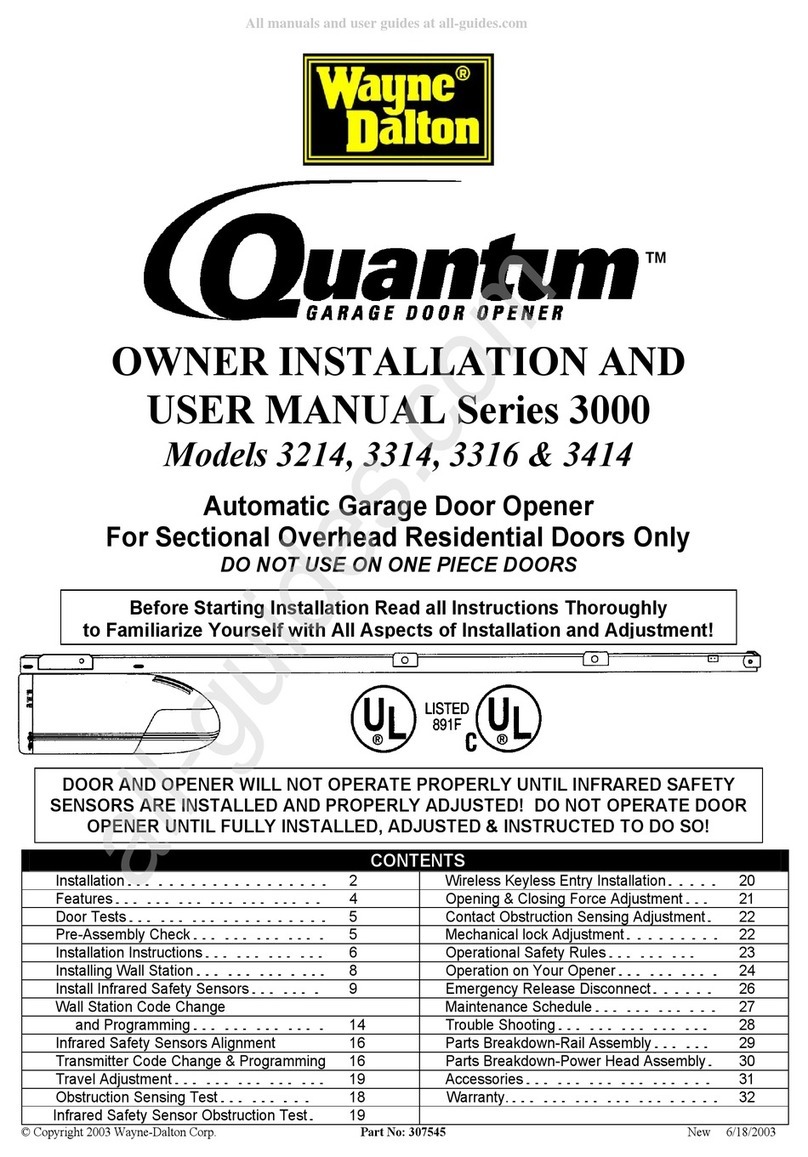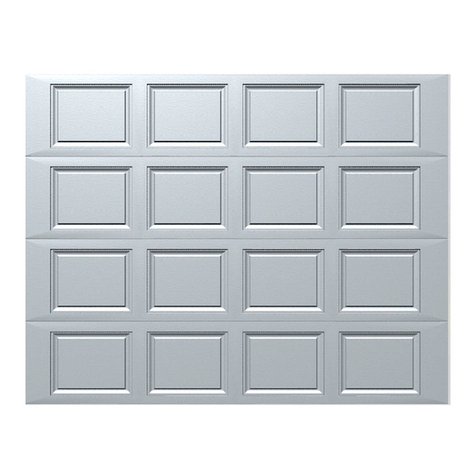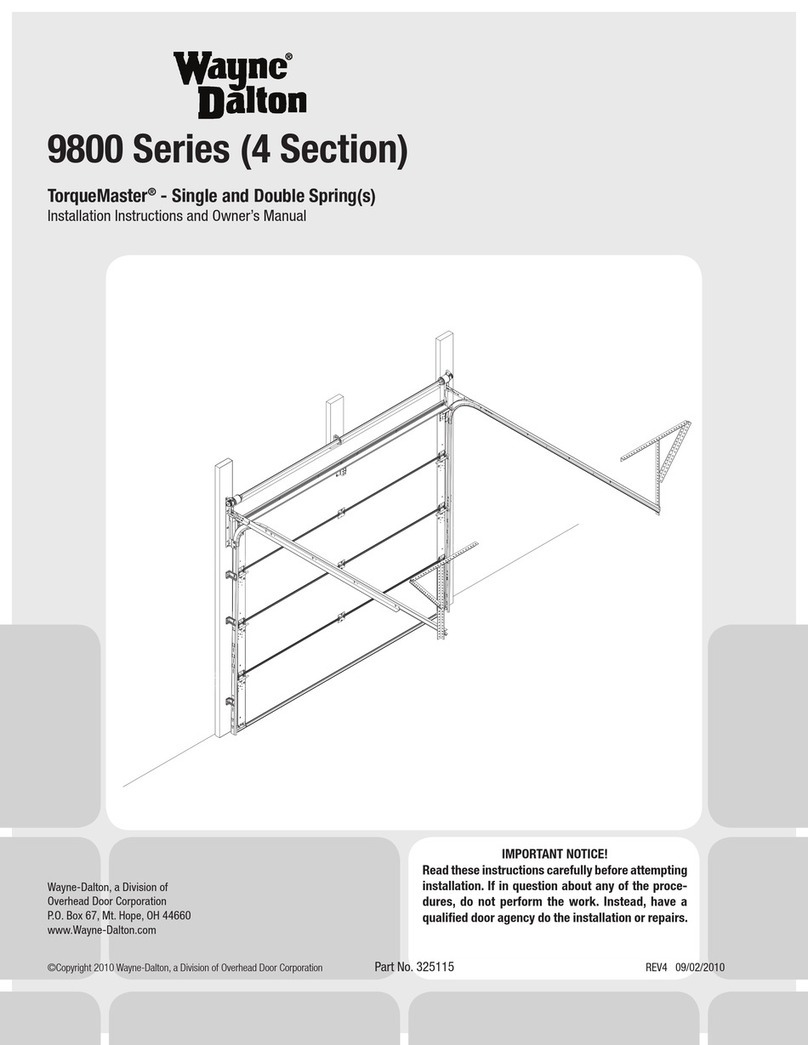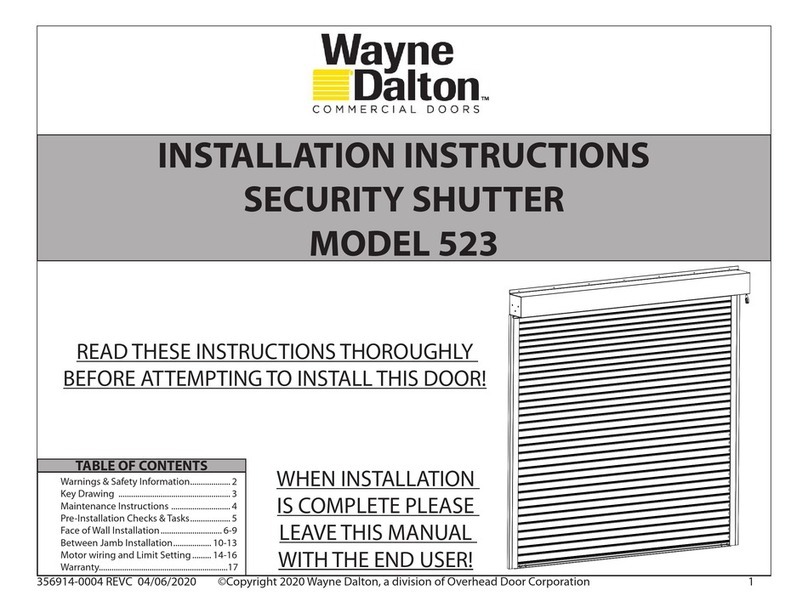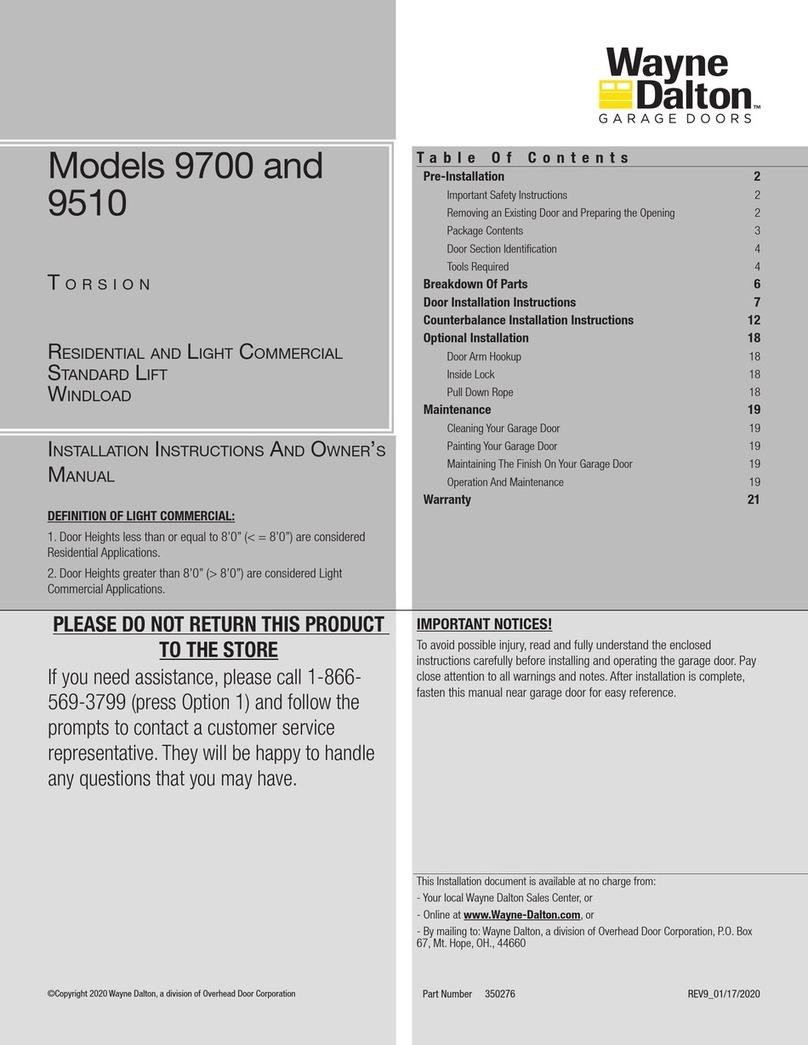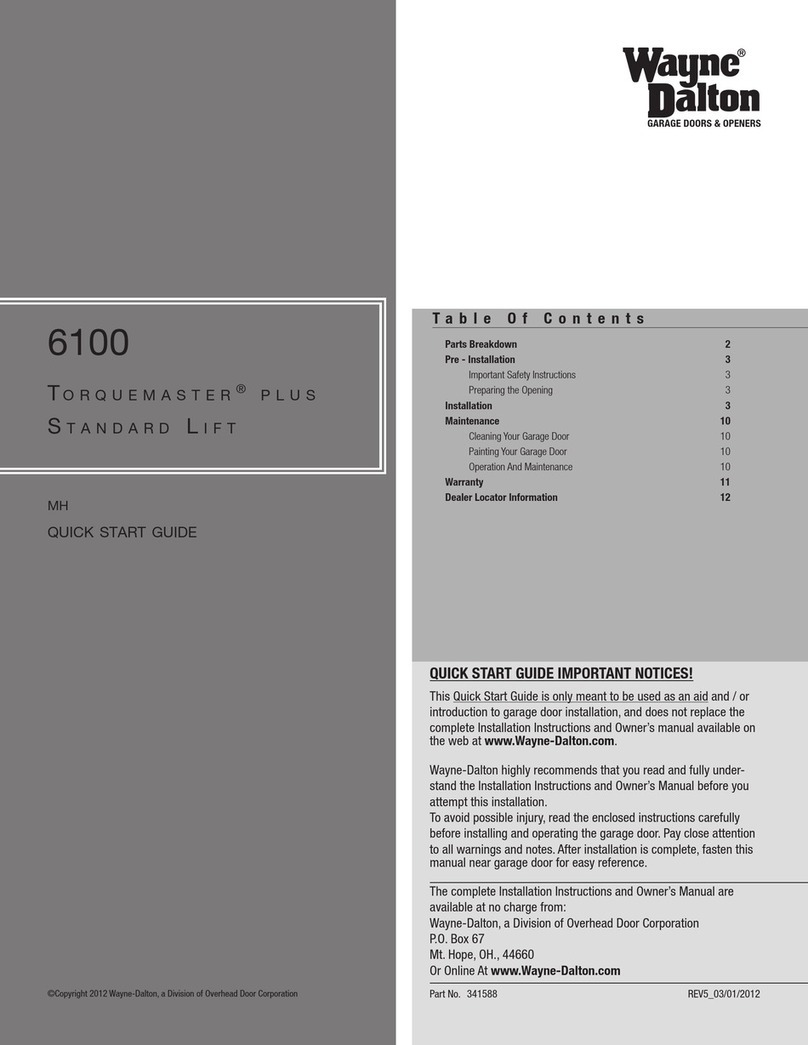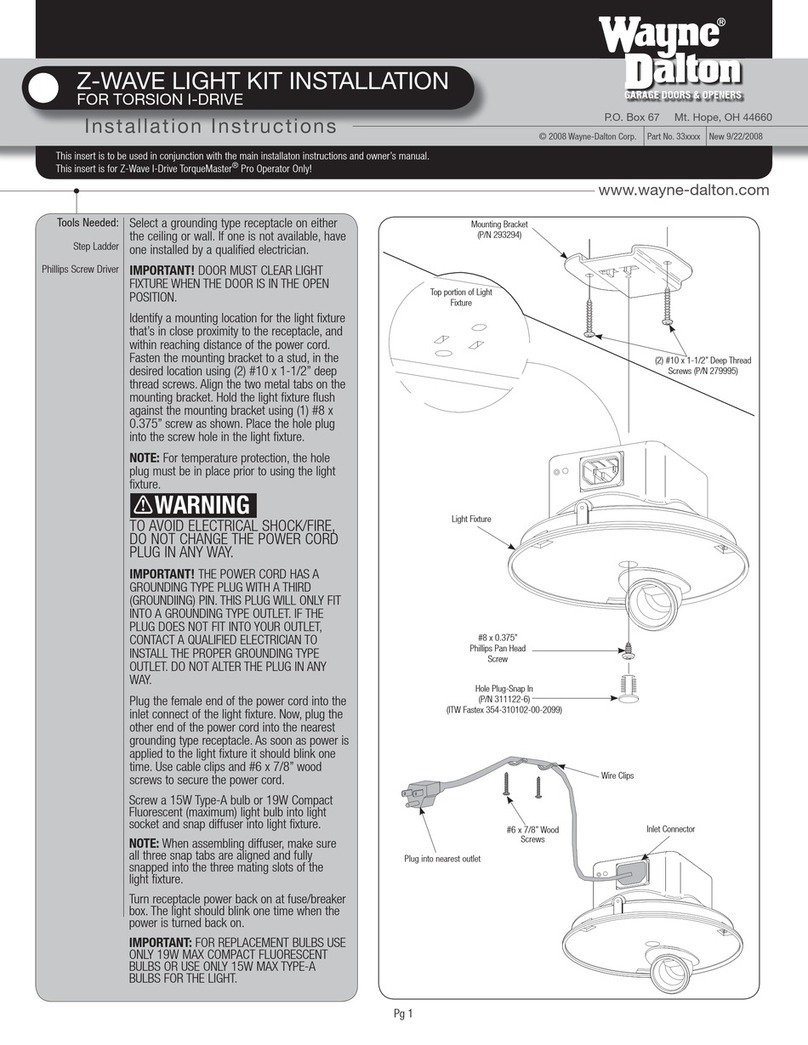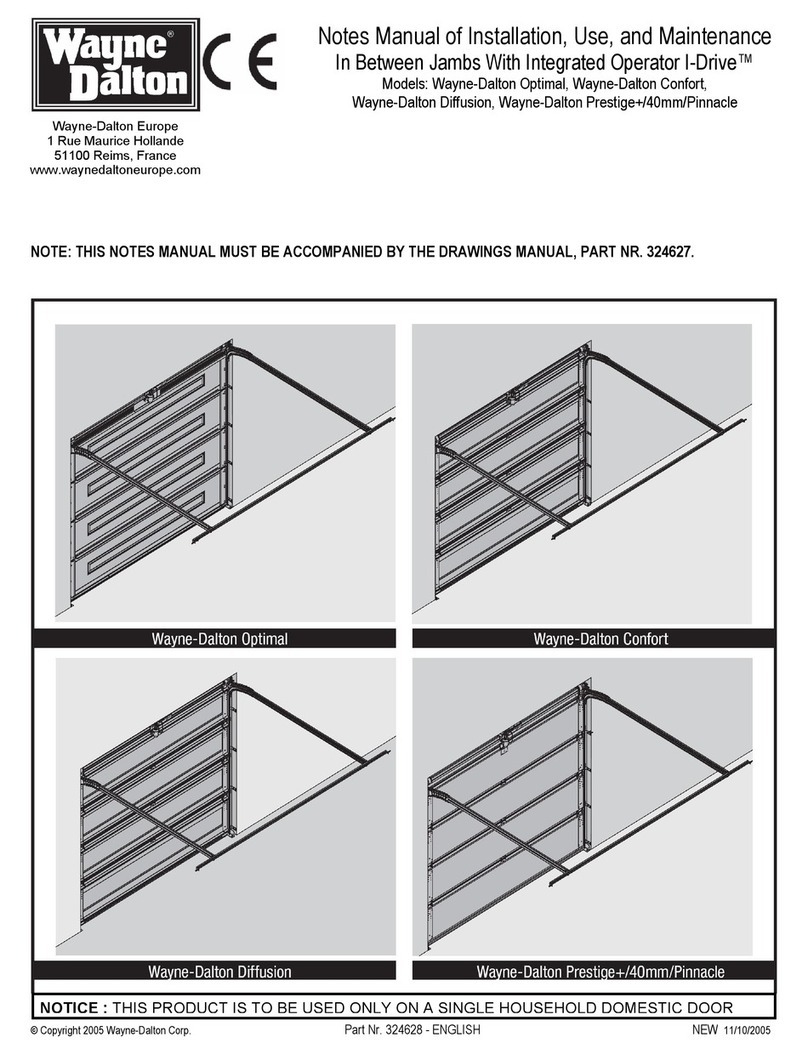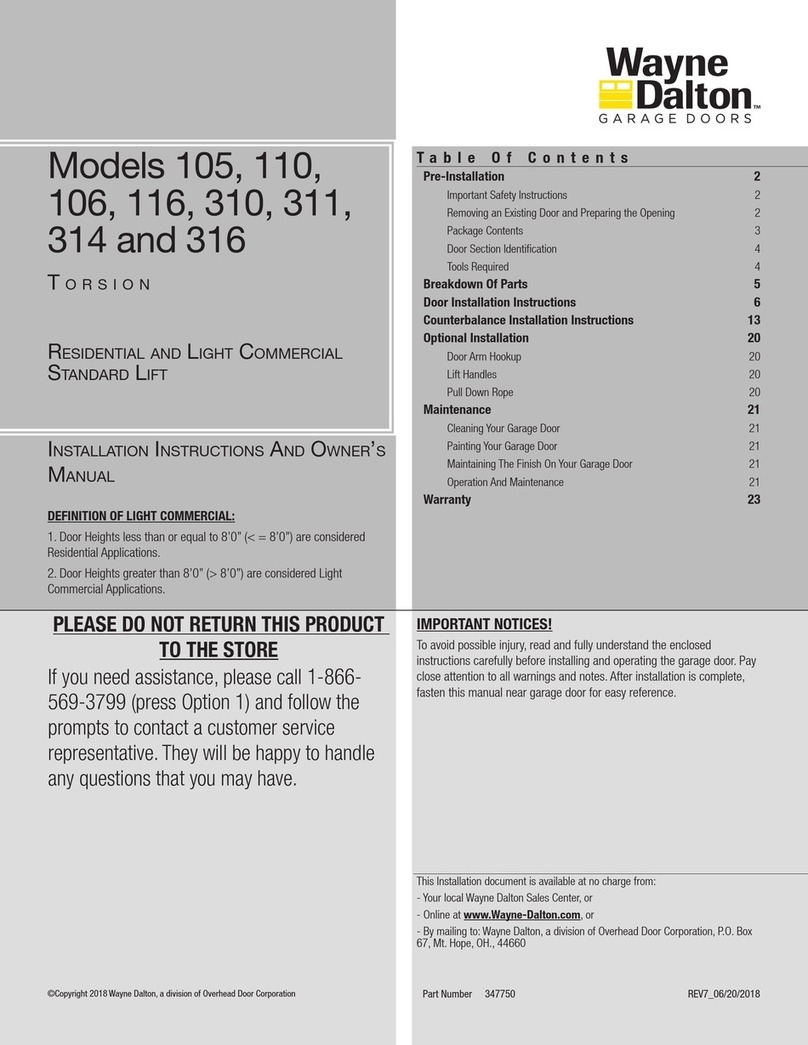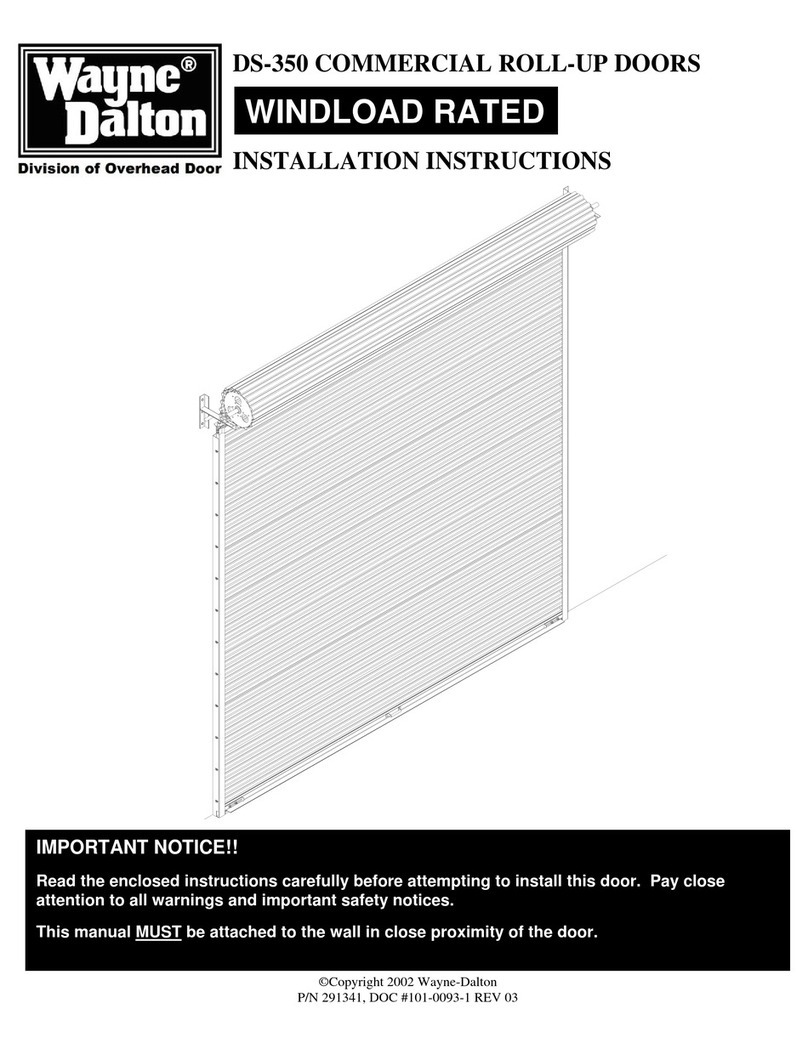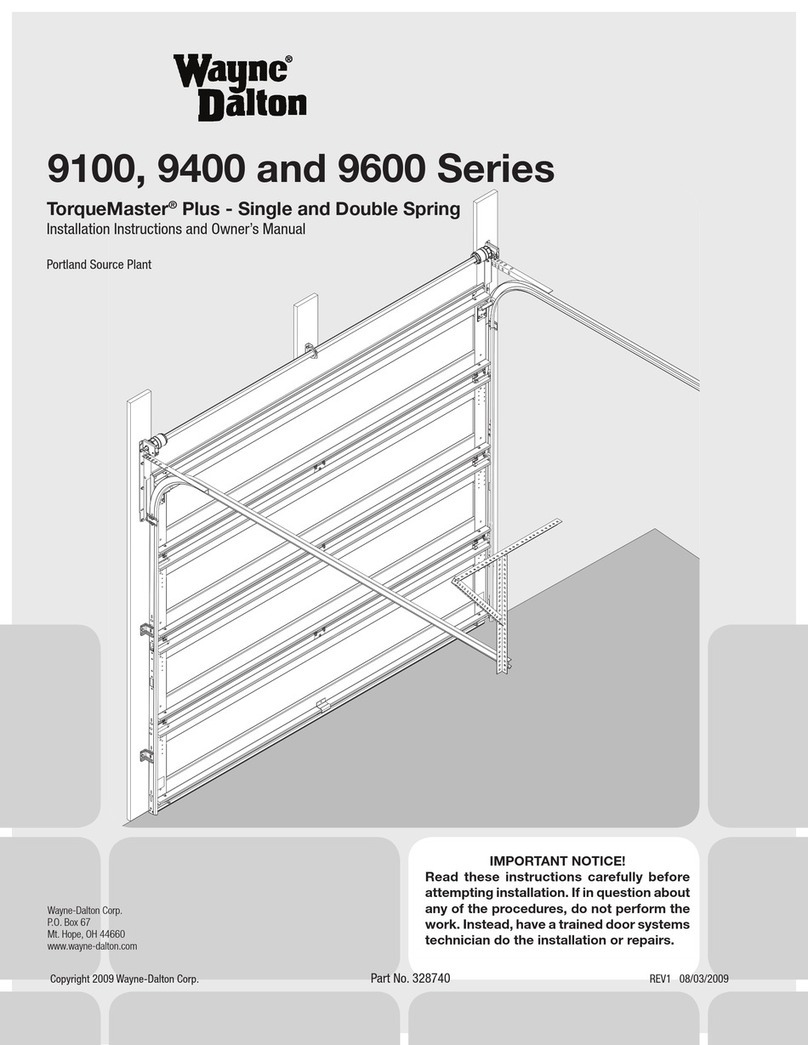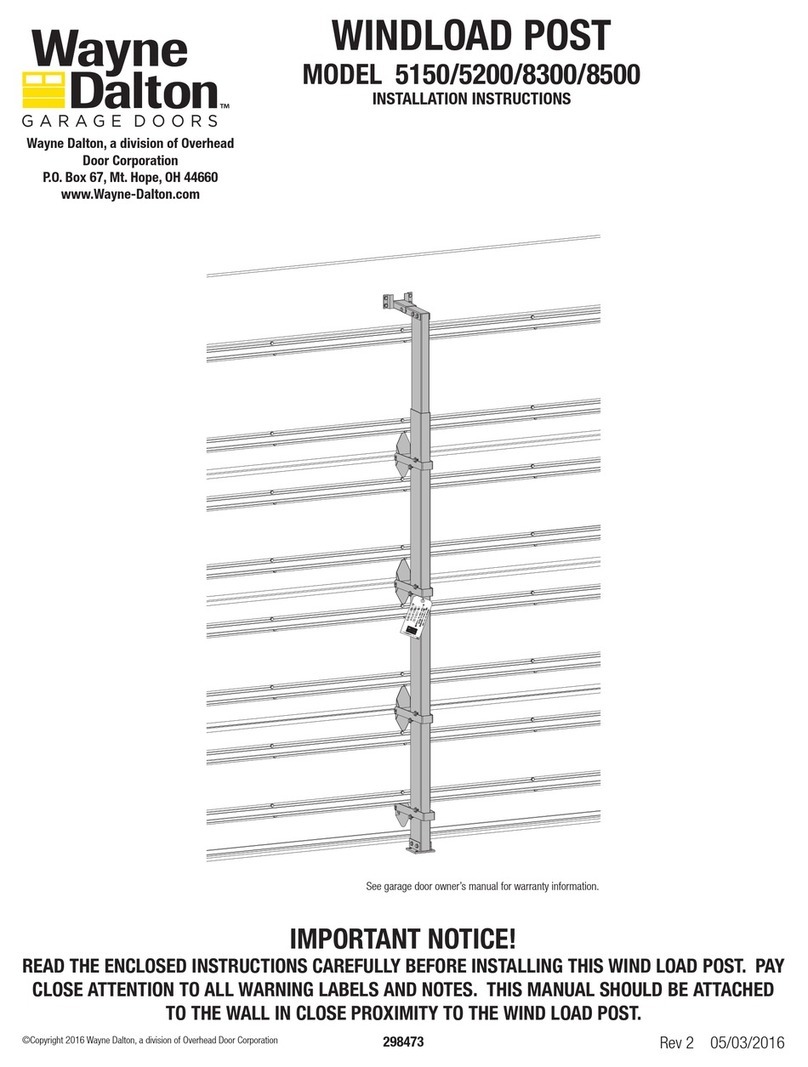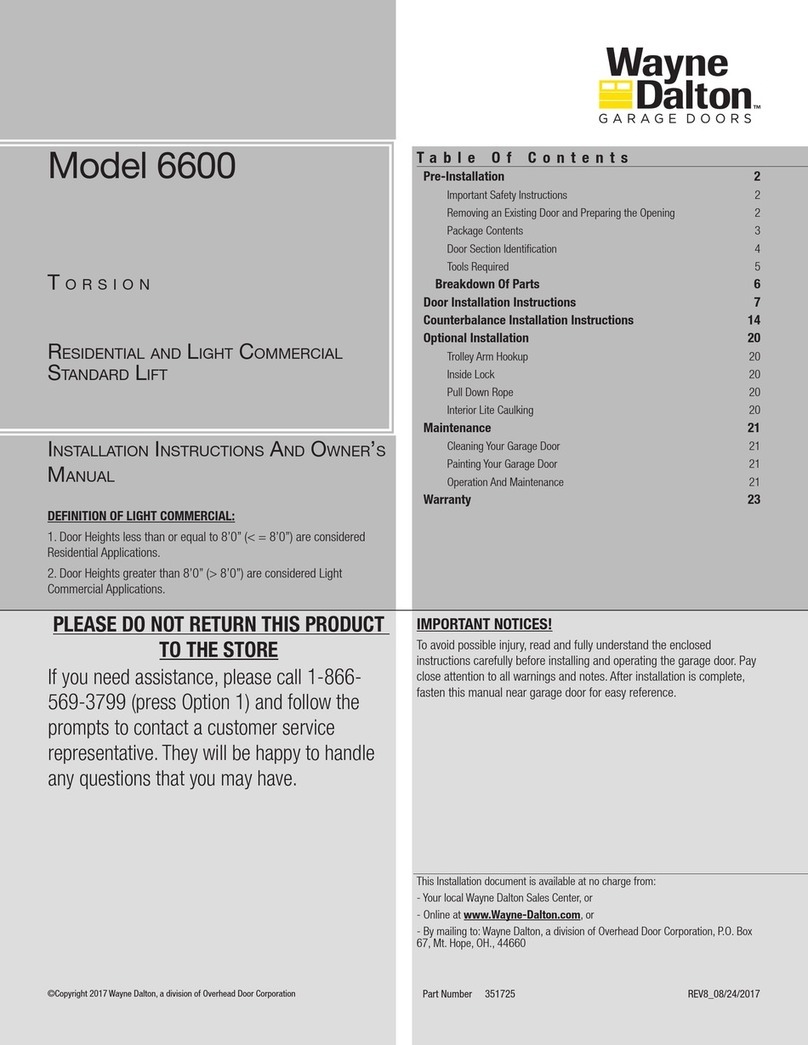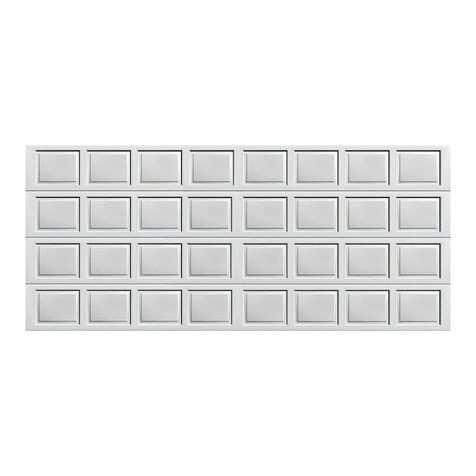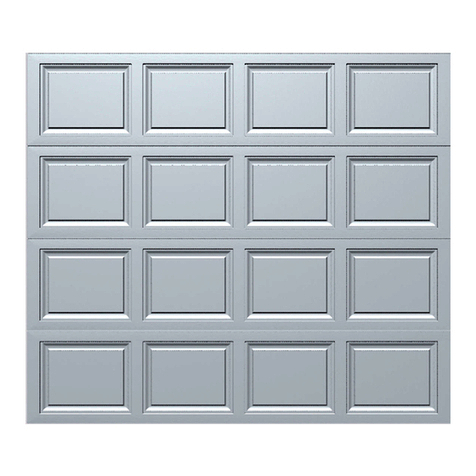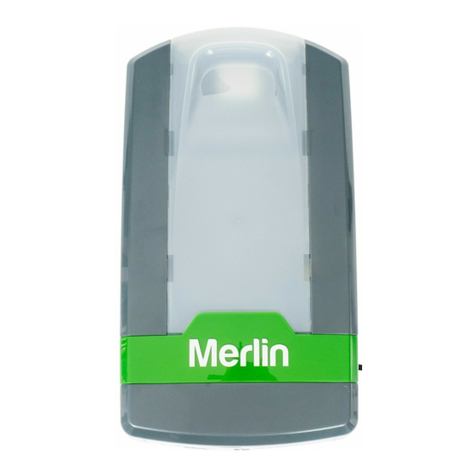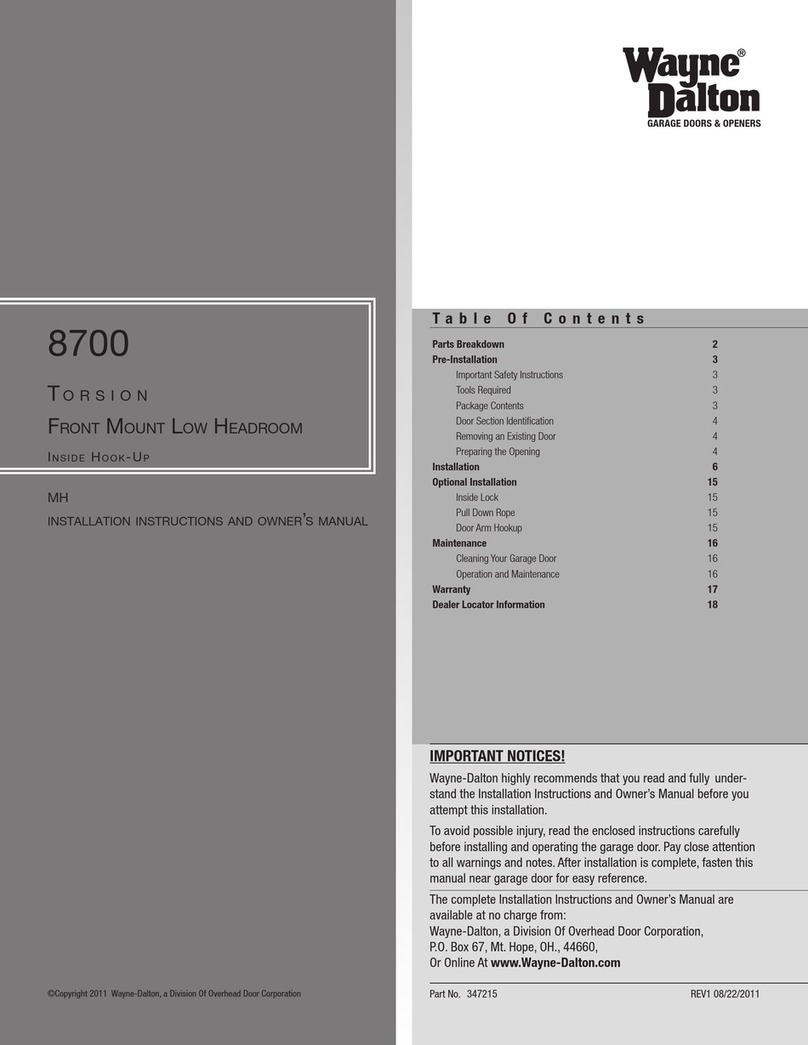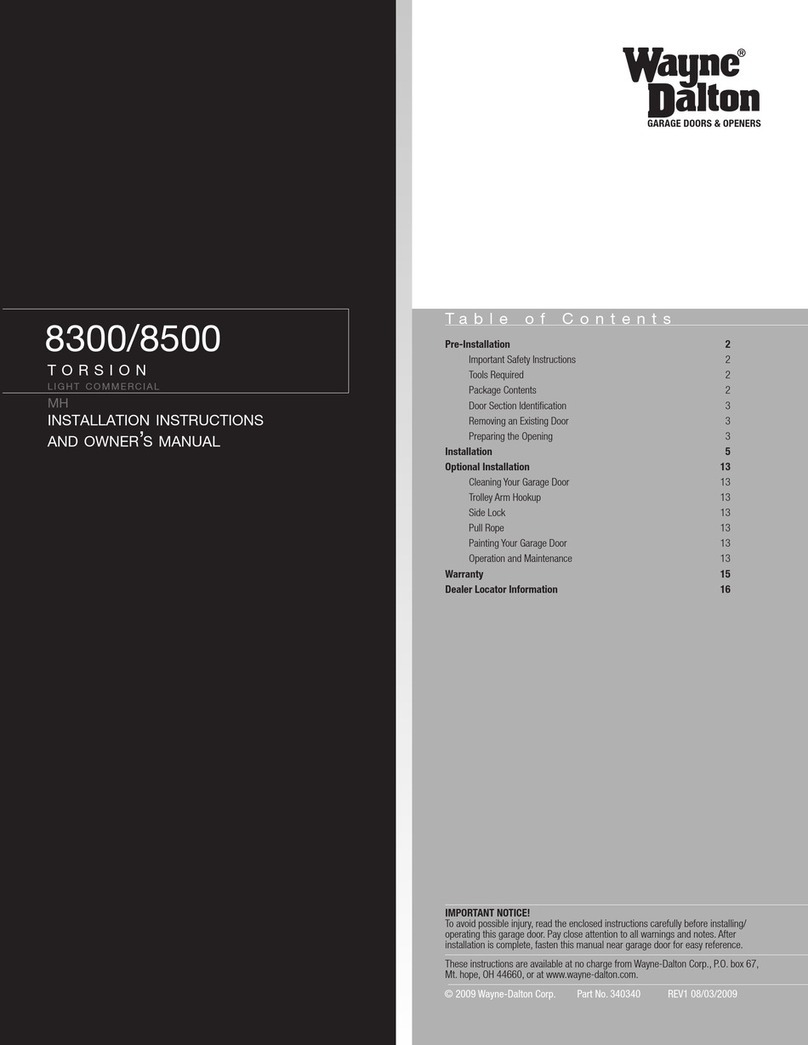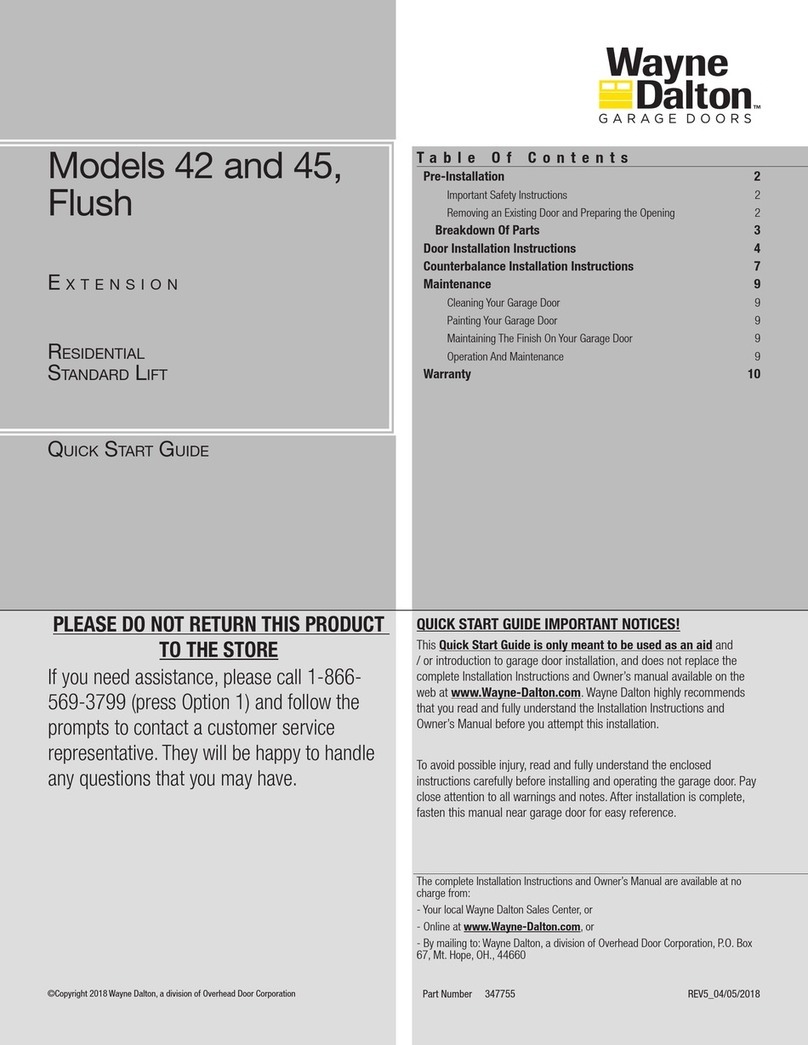
DOOR INSTALLATION
INSTRUCTIONS
Before installing your door, be certain that you have read and followed all of the instruc-
tions covered in the pre-installation section of this manual. Failure to do so may result in an
improperly installed door.
NOTE: Reference TDS 160 for general garage door terminology at www.dasma.com.
IMPORTANT: IF THE DOOR WILL BE EXPOSED TO A SIGNIFICANT AMOUNT OF ROAD SALT,
PAINT THE BARE GALVANIZED BOTTOM WEATHER STEEL RETAINER TO INHIBIT RUSTING.
Attaching Flag Angles and Jamb Brackets To
Vertical Tracks
1
NOTE: If you have Riveted Track or Angle Mount Track, skip this step.
FOR DOORS WITH FULLY ADJUSTABLE TRACK: Hand tighten the left hand flag angle to
the left hand vertical track using (2) 1/4” - 20 x 9/16” track bolts and (2) 1/4” - 20 flange
hex nuts.
NOTE: The bottom jamb bracket is always the shortest bracket, while the center jamb
bracket is the next tallest. If three jamb brackets per side are included with your door, you will
have received a top jamb bracket, which is the tallest.
To attach the bottom jamb bracket, locate lower hole of the hole/ slot pattern of the 1st hole
set on the vertical track. Align the slot in the jamb bracket with the lower hole of the hole/ slot
pattern. Hand tighten jamb bracket using (1) 1/4” - 20 x 9/16” track bolt and (1) 1/4” – 20
flange hex nut.
Place the center jamb bracket over the lower hole of the hole/ slot pattern that is centered
between the bottom jamb bracket and flag angle of the 2nd hole set. Hand tighten jamb
bracket using (1) 1/4” - 20 x 9/16” track bolt and (1) 1/4” - 20 flange hex nut.
If a top jamb bracket was included, hand tighten it to vertical track using the lower hole of the
hole/ slot pattern in the 3rd hole set and (1) 1/4” - 20 x 9/16” track bolt and (1) 1/4” - 20
flange hex nut.
Bottom Weather Seal
2
NOTE: Refer to door section identification, located in the pre-installation section of this
manual or refer to Breakdown of Parts.
NOTE: Verify that the bottom weather seal is aligned with bottom section. If needed, trim the
bottom weather seal even with bottom section length.
Position the bottom weather seal up against the bottom of the bottom section with the long
lip on the inside surface of the bottom section. From inside the door, attach the bottom
weather seal to the bottom section with 1/4” - 20 x 7/8” self drilling screws, placing one 6”
in from each end of the bottom section and one every 18” (maximum) in between, as shown.
Attaching Bottom Corner Brackets
3
NOTE: Refer to Package Contents / Breakdown of Parts, to determine which bottom corner
brackets you have.
Uncoil the counterbalance lift cables. Depending on which bottom corner brackets you have
(reference illustrations below), slip the loop at the ends of the counterbalance lift cable over
the milford pin of the bottom corner bracket or secure the cable loop to the clevis pin and
bottom corner bracket using a 5/16” flat washer and a cotter pin. Bend the ends of the cotter
pin outwards to secure it in place. Repeat for other side. Repeat for other bottom corner
bracket.
WARNING
FAILURE TO ENSURE TIGHT FIT OF CABLE LOOP OVER MILFORD PIN
COULD RESULT IN COUNTERBALANCE LIFT CABLE COMING OFF THE PIN,
ALLOWING THE DOOR TO FALL, POSSIBLY RESULTING IN SEVERE OR
FATAL INJURY.
Starting on the left hand side, attach the left hand bottom corner bracket to the left corner of
the bottom section, making sure it is seated to the edges of the end cap, using (3) 1/4” - 14
x 7/8” RED HEAD self drilling screws and 1/4” - 14 x 7/8” self drilling screws. Repeat for
right hand bottom corner bracket.
IMPORTANT: THE 1/4” - 14 X 7/8” RED HEAD SELF DRILLING SCREWS MUST BE MUST BE
INSTALLED THROUGH THE HOLES OF THE BOTTOM CORNER BRACKETS, AS SHOWN.
NOTE: Check to ensure cable loop fits tightly over the milford pins.
If applicable, insert a short stem track roller with roller spacer (if applicable) into the bottom
corner bracket. Repeat for other side.
NOTE: Verify bottom weather seal (bottom seal) is aligned with door section. If there is more
than 1/2” excess bottom weather seal on either side, trim bottom weather seal even with
door section.
Attaching Track Roller Carriers
4
NOTE: If you don’t have track roller carriers, then skip this step. Refer to Package Contents /
Breakdown Of Parts, to determine if you have track roller carriers.
Starting on left hand side of the bottom section, attach the track roller carrier with the stamp
“STD” facing UP to the bottom corner bracket by aligning the four holes of the track roller
carrier with the four holes in the bottom corner bracket. Secure the track roller carrier to the
bottom corner bracket with (4) 1/4” - 20 x 7/8” self drilling screws. Insert a short stem track
roller with roller spacer into each of the bottom corner brackets, as shown.
IMPORTANT: THE TRACK ROLLER CARRIER’S INNER HOLES ARE USED ON DOORS WITH 2”
TRACK APPLICATIONS; THE OUTER HOLES ARE USED ON DOORS WITH 3” TRACK APPLICA-
TIONS.
Attaching Hinges
5
NOTE: Refer to door section identification, located in the pre-installation section of this
manual to determine what size sections you need to use as your lock (second) section, inter-
mediate (third) section, intermediate (fourth) section, intermediate (fifth) section, intermediate
(sixth) section, intermediate (seventh) section and top section. Measure your sections to
make sure they are the correct height as indicated on the chart.
NOTE: The graduated end and center hinges can be identified by the number stamped onto
their lower hinge leaf.
NOTE: The #1, #2, #3, #4, #5, #6, #7 graduated end hinges (Wide body) serves as end
hinges on all sections, except for the top section.
NOTE: The #1 Center hinge(s) (Narrow body) serves as center hinges on all sections, except
for the top section.
Starting on the left hand side of the bottom section, align the lower hinge leaf of the #1
graduated end hinge (wide body) over the holes, located at the top of the end caps. Align the
lower hinge leafs of the #1 center hinges (narrow body) with the pre-marked locations at the
center locations at the top of the section. Attach the lower hinge leafs to the section using (2)
1/4” - 14 x 7/8” self drilling screws.
IMPORTANT: ONCE THE 1/4” - 14 X 7/8” SELF DRILLING SCREWS ARE SNUG AGAINST THE
LOWER HINGE LEAFS, TIGHTEN AN ADDITIONAL 1/4 TO 1/2 TURN TO RECEIVE MAXIMUM
DESIGN HOLDING POWER.
Place a short stem track roller into each graduated end hinge. Repeat graduated hinge
attachment using the appropriate graduated end hinges for all remaining sections except the
top section.
IMPORTANT: WHEN PLACING SHORT STEM TRACK ROLLERS INTO THE #2 GRADUATED
END HINGES AND HIGHER, THE SHORT STEM TRACK ROLLER GOES INTO HINGE TUBE
FURTHEST AWAY FROM SECTION.
NOTE: The #2 graduated end hinges serves as end hinges on the Lock section.
NOTE: The #3 graduated end hinges serves as end hinges on the Intermediate I section.
NOTE: The #4 graduated end hinges serves as end hinges on the Intermediate II section.
NOTE: The #5 graduated end hinges serves as end hinges on the Intermediate III section.
NOTE: The #6 graduated end hinges serves as end hinges on the Intermediate IV section.
NOTE: The #7 graduated end hinges serves as end hinges on the Intermediate V section.
Attaching Top Fixtures To Top Section
6
NOTE: Refer to door section identification, located in the pre-installation section of this
manual to determine what size sections you need to use as your top section.
NOTE: Refer to the strutting schedule below to determine the top section requires a strut. If
your top section is not noted in the strutting schedule, it doesn’t require a strut.
Top section Strutting Schedule
Section
Quantity
Section Type Solid / Win-
dows
Door Widths
6’0” - 10’0” 12’0” - 18’0”
4 - 8 Top Solid - 2”
Windows 2” 2”
Starting on the left hand side of the top section, align the edge of the top fixture parallel to
the top section edge, as shown. Fasten the top fixture to the top section using (2) 1/4” - 14
x 7/8” self drilling screws. Insert a short stem track roller into top fixture slide. Repeat same
process for other right hand side.
IMPORTANT: IF NO STRUT WAS INSTALLED ON THE TOP SECTION, PLACE (1) 1/4” - 14 X
7/8” SELF DRILLING SCREW INTO THE TOP PRE-PUNCHED HOLE IN EACH ENDSTILE OF THE
TOP SECTION.
Place the strut on top of the top fixture bases and on the top section. Center the strut side
to side on the top edge of the top section. Secure to the section using (2) 1/4” - 14 x 7/8”
self drilling screws at each endstile and (2) 1/4” - 14 x 7/8” self drilling screw at each center
hinge location at each pre-marked location.
5
